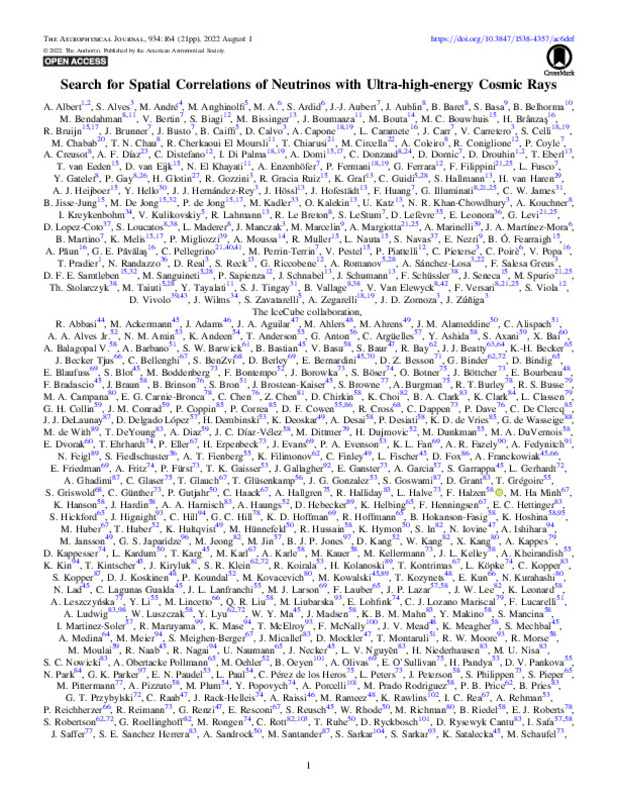|
Resumen:
|
[EN] For several decades, the origin of ultra-high-energy cosmic rays (UHECRs) has been an unsolved question of high- energy astrophysics. One approach for solving this puzzle is to correlate UHECRs with high-energy ...[+]
[EN] For several decades, the origin of ultra-high-energy cosmic rays (UHECRs) has been an unsolved question of high- energy astrophysics. One approach for solving this puzzle is to correlate UHECRs with high-energy neutrinos, since neutrinos are a direct probe of hadronic interactions of cosmic rays and are not de¿ected by magnetic ¿elds. In this paper, we present three different approaches for correlating the arrival directions of neutrinos with the arrival directions of UHECRs. The neutrino data are provided by the IceCube Neutrino Observatory and ANTARES, while the UHECR data with energies above ~50 EeV are provided by the Pierre Auger Observatory and the Telescope Array. All experiments provide increased statistics and improved reconstructions with respect to our previous results reported in 2015. The ¿rst analysis uses a high-statistics neutrino sample optimized for point-
source searches to search for excesses of neutrino clustering in the vicinity of UHECR directions.
The second analysis searches for an excess of UHECRs in the direction of the highest-energy
neutrinos. The third analysis searches for an excess of pairs of UHECRs and highest-energy
neutrinos on different angular scales. None of the analyses have found a signi¿cant excess, and previously reported over¿uctuations are reduced in signi¿cance.
Based on these results, we further constrain the neutrino ¿ux spatially correlated with UHECRs.
[-]
|
|
Agradecimientos:
|
The authors of the ANTARES collaboration acknowledge the financial support of the funding agencies: Centre National de la Recherche Scientifique (CNRS), Commissariat a l'energie atomique et aux energies alternatives (CEA), ...[+]
The authors of the ANTARES collaboration acknowledge the financial support of the funding agencies: Centre National de la Recherche Scientifique (CNRS), Commissariat a l'energie atomique et aux energies alternatives (CEA), Commission Europeenne (FEDER fund and Marie Curie Program), Institut Universitaire de France (IUF), LabEx UnivEarthS (ANR-10-LABX-0023 and ANR-18-IDEX-0001), Region Ile-de-France (DIM-ACAV), Region Alsace (contrat CPER), Region Provence-Alpes-Cote d'Azur, Departement du Var and Ville de La Seyne-sur-Mer, France; Bundesministerium fur Bildung und Forschung (BMBF), Germany; Istituto Nazionale di Fisica Nucleare (INFN), Italy; Nederlandse organisatie voor Wetenschappelijk Onderzoek (NWO), the Netherlands; Council of the President of the Russian Federation for young scientists and leading scientific schools supporting grants, Russia; Executive Unit for Financing Higher Education, Research, Development and Innovation (UEFISCDI), Romania; Ministerio de Ciencia, Innovacion, Investigacion y Universidades (MCIU): Programa Estatal de Generacion de Conocimiento (refs. PGC2018-096663-B-C41, -A-C42, -B-C43, -B-C44) (MCIU/FEDER), Generalitat Valenciana: Prometeo (PROMETEO/2020/019), Grisolia (refs. GRISOLIA/2018/119,/2021/192) and GenT (refs. CIDEGENT/2018/034,/2019/043,/2020/049,/2021/023) programs, Junta de Andalucia (ref. A-FQM-053-UGR18), La Caixa Foundation (ref. LCF/BQ/IN17/11620019), EU: MSC program (ref. 101025085), Spain; Ministry of Higher Education, Scientific Research and Innovation, Morocco, and the Arab Fund for Economic and Social Development, Kuwait. We also acknowledge the technical support of Ifremer, AIM and Foselev Marine for the sea operation and the CC-IN2P3 for the computing facilities. The ANTARES collaboration acknowledges the significant contributions to this manuscript from Julien Aublin.
[-]
|









